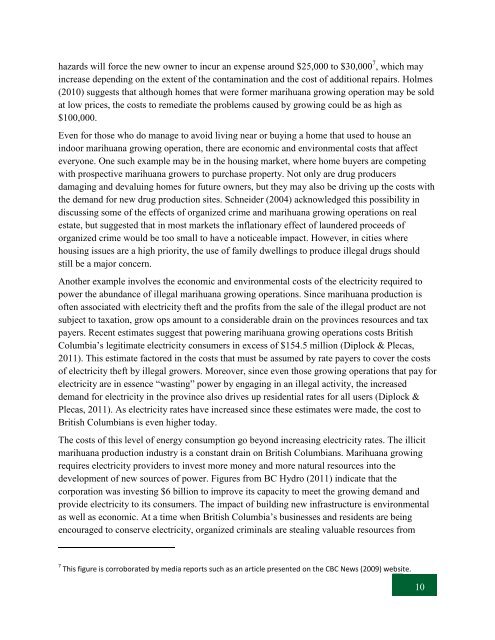Comercial+Grow+Op
Comercial+Grow+Op
Comercial+Grow+Op
You also want an ePaper? Increase the reach of your titles
YUMPU automatically turns print PDFs into web optimized ePapers that Google loves.
hazards will force the new owner to incur an expense around $25,000 to $30,000 7 , which may<br />
increase depending on the extent of the contamination and the cost of additional repairs. Holmes<br />
(2010) suggests that although homes that were former marihuana growing operation may be sold<br />
at low prices, the costs to remediate the problems caused by growing could be as high as<br />
$100,000.<br />
Even for those who do manage to avoid living near or buying a home that used to house an<br />
indoor marihuana growing operation, there are economic and environmental costs that affect<br />
everyone. One such example may be in the housing market, where home buyers are competing<br />
with prospective marihuana growers to purchase property. Not only are drug producers<br />
damaging and devaluing homes for future owners, but they may also be driving up the costs with<br />
the demand for new drug production sites. Schneider (2004) acknowledged this possibility in<br />
discussing some of the effects of organized crime and marihuana growing operations on real<br />
estate, but suggested that in most markets the inflationary effect of laundered proceeds of<br />
organized crime would be too small to have a noticeable impact. However, in cities where<br />
housing issues are a high priority, the use of family dwellings to produce illegal drugs should<br />
still be a major concern.<br />
Another example involves the economic and environmental costs of the electricity required to<br />
power the abundance of illegal marihuana growing operations. Since marihuana production is<br />
often associated with electricity theft and the profits from the sale of the illegal product are not<br />
subject to taxation, grow ops amount to a considerable drain on the provinces resources and tax<br />
payers. Recent estimates suggest that powering marihuana growing operations costs British<br />
Columbia’s legitimate electricity consumers in excess of $154.5 million (Diplock & Plecas,<br />
2011). This estimate factored in the costs that must be assumed by rate payers to cover the costs<br />
of electricity theft by illegal growers. Moreover, since even those growing operations that pay for<br />
electricity are in essence “wasting” power by engaging in an illegal activity, the increased<br />
demand for electricity in the province also drives up residential rates for all users (Diplock &<br />
Plecas, 2011). As electricity rates have increased since these estimates were made, the cost to<br />
British Columbians is even higher today.<br />
The costs of this level of energy consumption go beyond increasing electricity rates. The illicit<br />
marihuana production industry is a constant drain on British Columbians. Marihuana growing<br />
requires electricity providers to invest more money and more natural resources into the<br />
development of new sources of power. Figures from BC Hydro (2011) indicate that the<br />
corporation was investing $6 billion to improve its capacity to meet the growing demand and<br />
provide electricity to its consumers. The impact of building new infrastructure is environmental<br />
as well as economic. At a time when British Columbia’s businesses and residents are being<br />
encouraged to conserve electricity, organized criminals are stealing valuable resources from<br />
7 This figure is corroborated by media reports such as an article presented on the CBC News (2009) website.<br />
10


